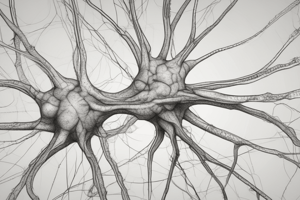Podcast
Questions and Answers
What is a characteristic of the contraction of a single skeletal muscle fiber?
What is a characteristic of the contraction of a single skeletal muscle fiber?
- It can be graded in strength
- It can be voluntarily altered in strength
- It is a brief all-or-none twitch (correct)
- It can be sustained for a long period of time
How does the nervous system produce graded contractions of whole muscles?
How does the nervous system produce graded contractions of whole muscles?
- By varying the number of muscle fibers that contract and the rate at which muscle fibers are stimulated (correct)
- By varying the type of muscle fibers stimulated
- By stimulating all muscle fibers simultaneously
- By stimulating different muscle groups
What determines the strength of contraction of a whole muscle?
What determines the strength of contraction of a whole muscle?
- The number of muscle fibers that contract (correct)
- The speed at which muscle fibers contract
- The type of muscle fibers stimulated
- The frequency of muscle fiber stimulation
Why can you voluntarily alter the extent and strength of a muscle's contraction?
Why can you voluntarily alter the extent and strength of a muscle's contraction?
What is the difference between the contraction of a single skeletal muscle fiber and a whole muscle?
What is the difference between the contraction of a single skeletal muscle fiber and a whole muscle?
What happens when a motor neuron produces an action potential?
What happens when a motor neuron produces an action potential?
What is the result of recruiting more and more motor neurons?
What is the result of recruiting more and more motor neurons?
What is the purpose of alternating activation among motor units in some muscles?
What is the purpose of alternating activation among motor units in some muscles?
What is a characteristic of muscles that hold up the body and maintain posture?
What is a characteristic of muscles that hold up the body and maintain posture?
What is a motor unit composed of?
What is a motor unit composed of?
What determines the strength of contraction of a motor unit?
What determines the strength of contraction of a motor unit?
What is the result of a single action potential on muscle fiber?
What is the result of a single action potential on muscle fiber?
What happens when the rate of muscle stimulation increases?
What happens when the rate of muscle stimulation increases?
What is tetanus in the context of muscle physiology?
What is tetanus in the context of muscle physiology?
What happens when a second action potential arrives before the muscle fiber has completely relaxed?
What happens when a second action potential arrives before the muscle fiber has completely relaxed?
What is the outcome when the rate of stimulation is so high that the muscle fiber cannot relax at all between stimuli?
What is the outcome when the rate of stimulation is so high that the muscle fiber cannot relax at all between stimuli?
Flashcards are hidden until you start studying
Study Notes
Nervous Control of Muscle Tension
- Contraction of a whole muscle (e.g., biceps) is graded, allowing for varying levels of strength and extent of contraction.
- Graded contractions are achieved by varying the number of muscle fibers that contract and the rate of muscle fiber stimulation.
Motor Units and Recruitment
- A motor unit consists of a single motor neuron and all the muscle fibers it controls.
- When a motor neuron produces an action potential, all muscle fibers in its motor unit contract as a group.
- The strength of the resulting contraction depends on the number of muscle fibers the motor neuron controls.
- Recruitment, or the activation of more motor neurons, increases the force developed by a muscle.
- The number of motor neurons recruited and the size of their motor units determine the level of muscle contraction.
Muscle Contraction and Relaxation
- A single action potential produces a twitch lasting about 100 milliseconds or less.
- Summation occurs when subsequent action potentials arrive before the muscle fiber has completely relaxed, resulting in greater tension.
- As the rate of stimulation increases, further summation occurs.
- At high rates of stimulation, muscle fibers cannot relax between stimuli, resulting in a smooth, sustained contraction called tetanus.
Studying That Suits You
Use AI to generate personalized quizzes and flashcards to suit your learning preferences.




